Cite this document
(“Respiration in Human Lung Function Research Paper”, n.d.)
Respiration in Human Lung Function Research Paper. Retrieved from https://studentshare.org/health-sciences-medicine/1528277-respiration-in-human-lung-function
Respiration in Human Lung Function Research Paper. Retrieved from https://studentshare.org/health-sciences-medicine/1528277-respiration-in-human-lung-function
(Respiration in Human Lung Function Research Paper)
Respiration in Human Lung Function Research Paper. https://studentshare.org/health-sciences-medicine/1528277-respiration-in-human-lung-function.
Respiration in Human Lung Function Research Paper. https://studentshare.org/health-sciences-medicine/1528277-respiration-in-human-lung-function.
“Respiration in Human Lung Function Research Paper”, n.d. https://studentshare.org/health-sciences-medicine/1528277-respiration-in-human-lung-function.


